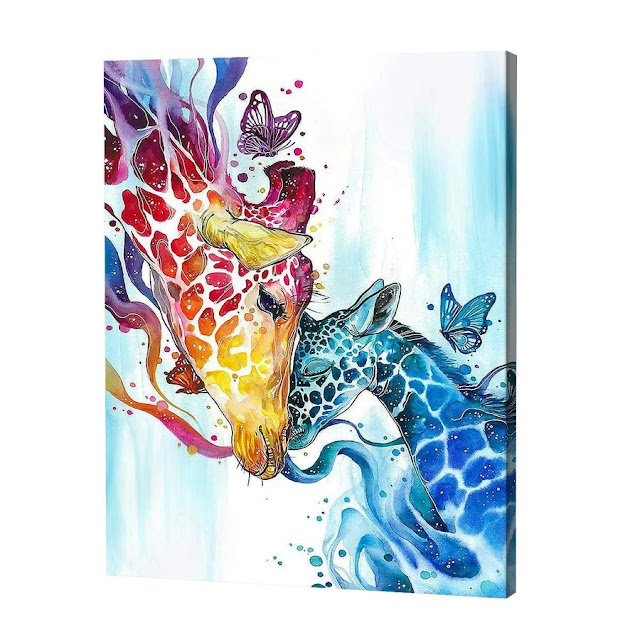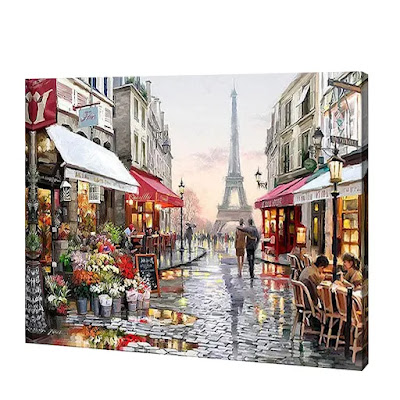Tips for Finishing Your Paint By Numbers Project Faster
Paint by numbers is a wonderful activity that brings out the
artist in everyone, providing a structured way to create stunning artwork.
While this hobby is a relaxing escape, sometimes you might want to finish your
project faster—maybe for a gift deadline or simply to enjoy the accomplishment.
If you’re eager to see your masterpiece complete sooner, here are some
effective tips to speed up your paint-by-numbers process without compromising
quality.
1. Organize Your Workspace Before Starting
A well-organized workspace can save you a lot of time.
Before you start, ensure you have all the necessary tools at hand. Arrange your
paints in order, set up a clean water cup, and have paper towels nearby to
clean your brushes quickly between colors. Clear any distractions and make sure
your lighting is good to avoid straining your eyes.
Use a palette or tray to line up the colors in numerical
order. This setup prevents you from constantly looking for the right shade and
allows you to smoothly transition between colors, cutting down on interruptions
and maximizing your focus.
2. Choose the Right Brushes for Each Section
Using the correct brush size for each part of your painting
can significantly affect your speed. For larger areas, opt for a broader brush
to cover more ground quickly. Conversely, use finer brushes for intricate,
small sections to maintain precision without having to go back and correct
mistakes.
Some paint-by-numbers
kits come with a variety of brush sizes, but if you find the included
brushes too basic or flimsy, investing in quality brushes can improve both your
speed and the final result. With practice, you’ll learn which brush size suits
each part, making the process smoother and faster.
3. Start with the Larger Sections First
Tackling the larger sections at the beginning helps you
cover a significant portion of your canvas quickly. Large areas with a single
color are usually easier to paint, allowing you to make visible progress right
from the start. This can be motivating and gives you a sense of accomplishment
early on.
Once the large areas are done, focus on the smaller sections
and finer details. Starting big and then moving to smaller areas is efficient,
as you won’t accidentally smudge detailed parts while handling the canvas.
4. Use a “One Color at a Time” Approach
Instead of constantly switching colors, try completing all
areas of the canvas that require a single color before moving on to the next.
This approach saves time, as you won’t have to clean your brush repeatedly,
especially if you’re working with similar shades.
Using one color across the canvas reduces the need to search
for specific numbered sections repeatedly, making it easier to complete the
project methodically. It’s also less mentally tiring, as you get into a rhythm
and cover more ground without pausing.
5. Work from Top to Bottom or Left to Right
To prevent accidental smudges, especially if you’re
right-handed, start at the top-left corner of the canvas and work your way down
and across to the right. This pattern ensures that your hand doesn’t rest on
freshly painted areas, which can lead to smudges and time-consuming
corrections.
If you’re left-handed, start from the top-right and work
toward the left. Following a consistent direction also provides a visual sense
of progress, making the painting feel manageable as you move from one side to
the other.
6. Keep Multiple Brushes on Hand
Instead of rinsing your brushes between each color, consider
using multiple brushes, especially if you have similar shades close to each
other. Having separate brushes ready can save a lot of time, as you’ll be able
to move quickly between colors without needing to clean your brush each time.
You can dedicate one brush to darker colors, another to
lighter ones, and a third for fine detailing. Having multiple brushes makes it
easy to shift between sections, allowing you to focus on the painting itself.
7. Thin the Paint for Easier Application
Some paint-by-numbers kits come with thick paint, which can
slow down your progress as it may require multiple strokes to cover an area. By
adding a small amount of water to your paint, you can make it easier to apply
and create smoother strokes.
A thinner consistency spreads across the canvas faster and
evenly, reducing the time spent on each section. Be cautious not to over-dilute
the paint, as this can affect the color’s vibrancy. Start with a few drops of
water and test the consistency on a small area before applying it to larger
sections.
8. Use a Magnifying Glass for Intricate Details
For areas with very fine detail, a magnifying glass can be a
great asset. It allows you to paint smaller sections accurately without having
to adjust your brushwork repeatedly, which can save time and prevent errors.
Magnifying glasses with LED lights are even better, as they
provide focused lighting on tiny details, helping you finish them quicker. This
approach minimizes the need for corrections and rework, allowing you to
maintain your speed and accuracy.
9. Take Breaks to Avoid Fatigue
It may seem counterintuitive, but taking short breaks can
actually help you complete your painting faster. Long periods of continuous
work can lead to fatigue and decrease your focus, increasing the likelihood of
mistakes. A five-minute break every 30-45 minutes allows you to return to your
work refreshed and more efficient.
Breaks also reduce the strain on your eyes and hands, which
is especially important for a detailed activity like paint by numbers. Working
when you’re fresh and focused helps you paint accurately, reducing the time
spent fixing errors or filling in missed areas.
10. Keep a Steady Hand for Cleaner Lines
Maintaining a steady hand helps prevent messy lines and
smudges, which can take extra time to correct. To keep your hand steady, try
resting the side of your painting hand on the table or on the edge of the
canvas as you paint.
Practice makes perfect with steady hands, and the more you
paint, the better control you’ll gain. Precision the first time around
minimizes the need for touch-ups, which can add to the project’s completion
time.
11. Consider Pre-Mixing Similar Shades
Some kits come with shades that are very similar, requiring
you to switch between close hues for a gradual effect. If you’re comfortable
with color blending, pre-mixing similar shades can save time.
By creating the gradient in one go, you avoid the hassle of
switching shades too often. This approach requires practice to get the shades
right, so consider testing on a separate piece before applying it to the actual
painting.
12. Avoid Overworking the Canvas
Sometimes, the desire for perfection can lead us to overwork
certain sections of the canvas, trying to make them flawless. Trust the design
of the paint-by-numbers kit, which is meant to look cohesive once completed,
even if some sections don’t seem perfect up close.
The goal is to enjoy the painting process and finish the
project, not necessarily to achieve professional-level detail. Focusing on
steady progress rather than perfect detail helps you keep up the momentum and
reach the finish line faster.
13. Embrace a “Good Enough” Mindset
Paint by numbers is meant to be a fun and relaxing hobby,
not a professional art piece. Adopting a “good enough” mindset can prevent you
from spending excessive time on minor details. It’s important to remember that
minor imperfections are part of the process, and your painting will still look
beautiful when complete.
Rather than over-focusing on tiny corrections, enjoy the
bigger picture—literally. A healthy balance between precision and flexibility
will help you stay on track and finish your project efficiently.
Final Thoughts
Paint by numbers is a great way to create art while
relaxing, and speeding up the process doesn’t mean compromising on quality.
With a few strategic adjustments to your workflow—such as organizing your
workspace, using the right brushes, working with one color at a time, and
keeping a steady hand—you can complete your masterpiece more quickly and with
minimal frustration. By following these tips, you’ll be able to enjoy the
satisfaction of a finished painting, possibly inspiring you to take on even
more projects with confidence and efficiency. Happy painting!




Comments
Post a Comment